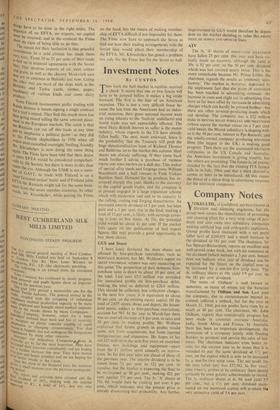Investment Notes
By CUSTOS
Mini week the bull market in equities received a check. It seems that one or two fences will have to be jumped before it makes a big stride forward. The first is the fear of an American recession. This is not a very difficult fence be- cause the last time the Americans had an indus- trial recession, their gross national income went on rising (thanks to the 'built-in' stabilisers) and world trade was not appreciably affected. The most likely British interest to suffer is the motor industry, whose exports to the US have already fallen badly. The next, more awkward, fence is the probability that the Treasury will push the huge denationalisation issue of Richard Thomas and Baldwins on to the market this autumn. Steel shares are already suffering. If they conic back much further 1 advise a purchase of THOMAS FIRTH AND JOHN BROWN on a dull day. This maker of'special alloy steels and forgings owns William Beardmore and a half interest in Firth Vickers Stainless Steel. Demand for its products has re- covered sharply this year, thanks to the recovery in the capital goods trades, and the company is at present engaged in a large expansion scheme which will modernise and add to its capacity in the rolling, casting and forging departments. An increased interim dividend of 5 per cent. has been paid and a 1 per cent. rise in the final, making a total of 12 per cent, is likely, with earnings cover- ing it four or five times. At 53s. the potential yield would be about 43 per cent. If the market falls again on the publication of bad export figures, this may provide a good opportunity to buy these shares.
GUS and Stores I have lately favoured the store shares not affected by hire-purchase restrictions, such as
MONTAGUE BURTON, but Mr. Wolfson's report on GREAT UNIVERSAL STORES was very reassuring on this point. The proportion of their domestic hire- purchase sales is down to about 10 per cent. of the total. Last year £5.7 million was provided for unrealised profits on hire-purchase debts, making the total so deferred to £20.6 million. This should be collected, less collection changes, in the next few years; it is equivalent to about 90 per cent. on the existing equity capital. Of the total of 2,675 stores, shops and depots, the house- hold stores, subject to hire-purchase restrictions, account for 565. In the year to March last there was an over-all increase of 8 per cent. in sales and 10 per cent. in trading profits. Mr. Wolfson explained that future growth in profits would come, not from acquisitions, but from internal reorganisation and expansion. He hopes to lay out £25 million in the next five years on customer finance, new buildings and equipment—apart from the £1 million spent annually on renova- tions. So far this year sales are ahead of those of the previous year. The interim dividend is to be raised from 73 per cent. to 123 per cent. to equalise. but the market is expecting the final to be maintained at 30 per cent., making 423 per cent. against 373 per cent. The 5s. 'A' shares at 51s. 6d, would then be yielding just over 4 per cent., which indicates that the present price is already discounting that probability. Any further
improvement in GUS would therefore be depen- dent on the market deciding to value this equity more on wows AND SPENCER lines.
.ATV
The 5s. 'A' shares of Assoc:IA.1-ED TELEVISION have fallen 25 per cent. this year and have vir- tually made no recovery, although the yield at 30s. is 81 per cent. on the 50 per cent. dividend which was last covered nearly twice. This is the more remarkable because Mr. Prince Littler, the chairman, regards the results as 'eminently satis- factory.' The market is, however, depressed by the unpleasant fact that the point of saturation has been reached in advertising revenues--the increase in costs and slight cut in advertising time have so far been offset by increases in advertising charges which can hardly be pressed further—but there are other revenue-producing assets which can develop. The company has a• £23 million stake in BRITISH RELAY WIRELESS AND TELEVISION (whose equity the market values on a 3 per cent. yield basis); the Muzak subsidiary is shaping well; so is the 50 per cent. interest in Pyc Records; and the wholly-owned company producing television films (the largest in the UK) is making good progress. Then there are the associated television companies in the US, Canada and Australia: the American investment is giving trouble, but the others are promising. The future is, of course, • clouded by the fact that the existing ITA licence falls in in July, 1964, and that a third channel is sooner or later to be introduced. All this causes the threat of a sharp drop in advertising revenues for the television companies.


































 Previous page
Previous page